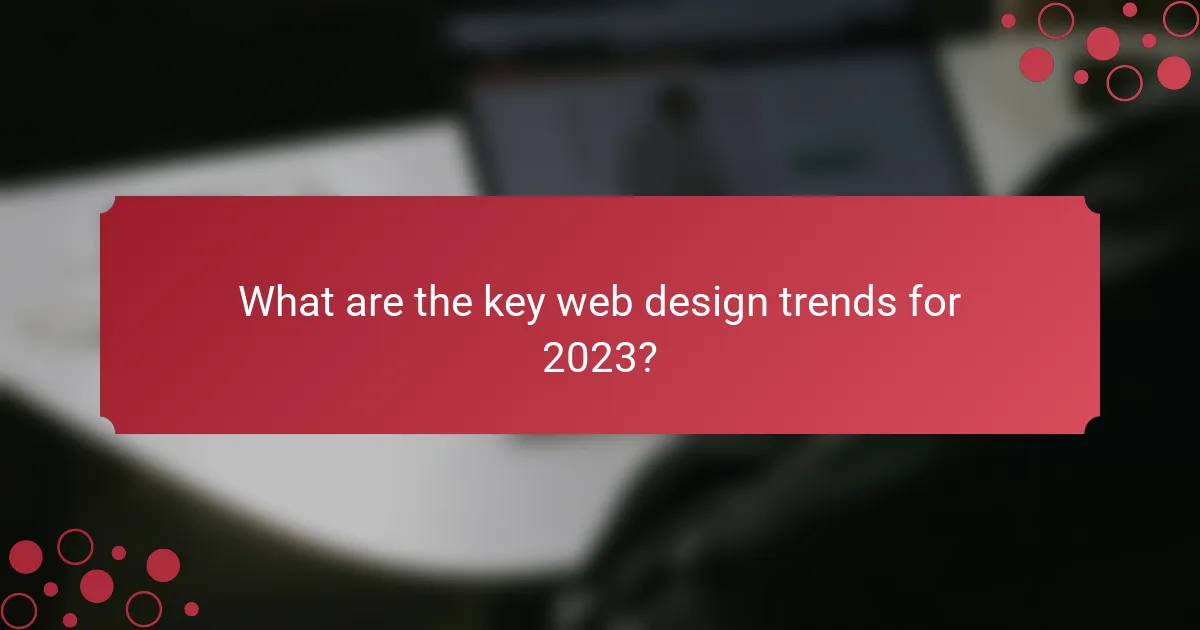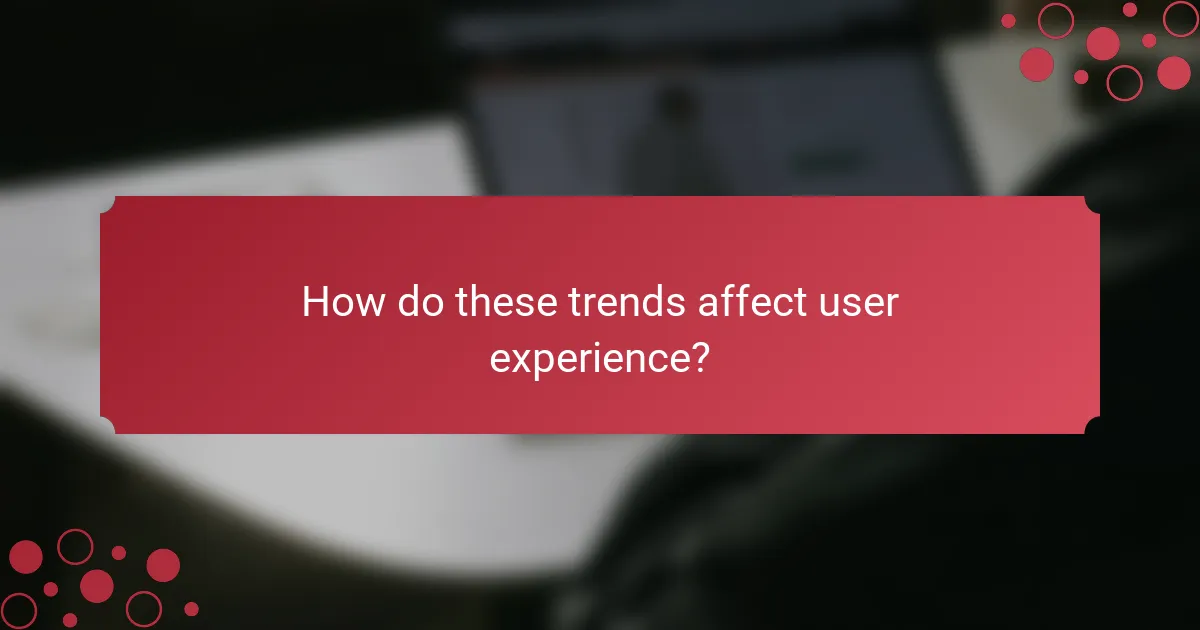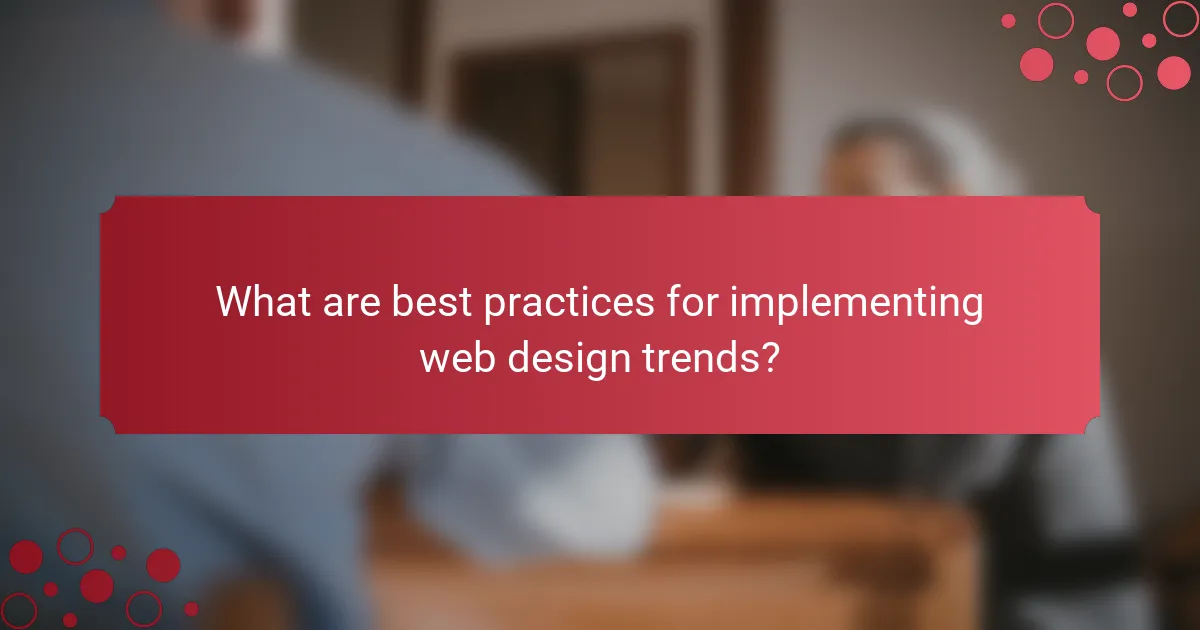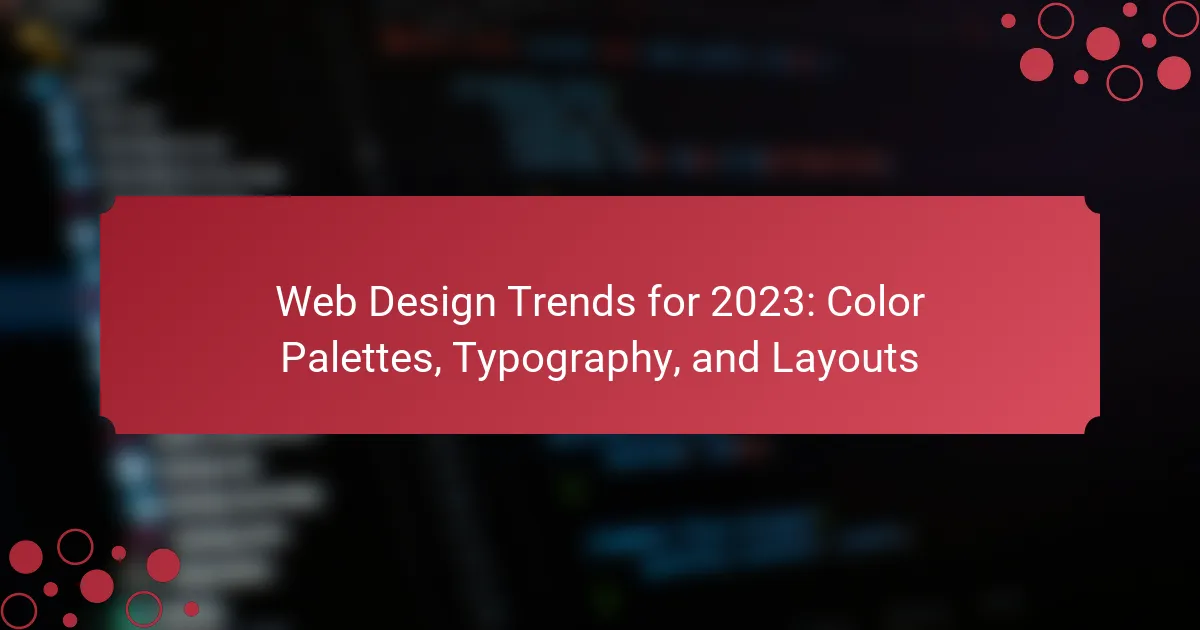Web design trends for 2023 focus on key elements such as color palettes, typography, and layouts, which significantly impact user experience. Minimalism emphasizes simplicity and functionality, while bold typography captures attention and conveys messages effectively. Dark mode is gaining popularity for its aesthetic appeal and reduced eye strain, alongside vibrant color palettes that enhance user engagement. Responsive design remains crucial for mobile optimization, ensuring accessibility and improved navigation. Best practices for implementing these trends include thorough research, user testing, and data-driven adjustments to maintain brand identity and enhance overall website performance.

What are the key web design trends for 2023?
Key web design trends for 2023 include minimalism, bold typography, and dark mode. Minimalism focuses on simplicity and functionality. This trend enhances user experience by reducing clutter. Bold typography makes a strong visual impact. It captures attention and conveys messages effectively. Dark mode is popular for its aesthetic appeal and reduced eye strain. It also helps save battery life on OLED screens. Additionally, vibrant color palettes are emerging, creating engaging user interfaces. Responsive design remains essential for mobile optimization. These trends reflect evolving user preferences and technological advancements in web design.
How do color palettes influence web design in 2023?
Color palettes significantly influence web design in 2023 by affecting user perception and engagement. A well-chosen color palette enhances brand identity and sets the emotional tone of a website. For instance, warm colors can evoke feelings of comfort, while cool colors often convey professionalism. Research indicates that color can increase brand recognition by up to 80%. Moreover, accessibility considerations have become paramount. Designers now prioritize color contrast to ensure readability for all users. Trends show that minimalist palettes are gaining popularity, simplifying the user experience. Ultimately, effective color palettes create visually appealing designs that improve user interaction and satisfaction.
What are the most popular color palettes this year?
The most popular color palettes this year include earthy tones, vibrant pastels, and monochromatic schemes. Earthy tones like terracotta and olive green are favored for their calming effects. Vibrant pastels such as soft pinks and mint greens provide a fresh, modern look. Monochromatic schemes utilize varying shades of a single color for a cohesive design. These palettes reflect a trend towards sustainability and minimalism in web design. According to design surveys, these color choices enhance user experience and engagement.
How can color psychology enhance user experience?
Color psychology can enhance user experience by influencing emotions and behaviors through color choices. Specific colors evoke distinct feelings; for instance, blue often conveys trust and calmness. This can lead to increased user engagement on websites. Red, known for its urgency, can drive action, such as prompting users to make a purchase. Research indicates that color can increase brand recognition by up to 80%. Effective use of color schemes can guide users’ attention to key elements, improving navigation. Overall, understanding color psychology allows designers to create more intuitive and appealing user interfaces.
What role does typography play in modern web design?
Typography plays a crucial role in modern web design. It enhances readability and user experience on websites. Effective typography establishes hierarchy and guides user attention. It influences brand perception and communicates tone. Consistent font choices contribute to a cohesive design. The right typography can improve accessibility for diverse audiences. Research shows that good typography increases user engagement and retention. For instance, a study by the Nielsen Norman Group highlights that users read 20% slower on poorly designed text. Thus, typography is essential for effective communication in web design.
Which typography styles are trending in 2023?
Bold typography, oversized fonts, and minimalistic designs are trending in 2023. These styles emphasize clarity and impact. Bold typography captures attention and enhances readability. Oversized fonts create a strong visual hierarchy on web pages. Minimalistic designs focus on essential elements, reducing clutter. Additionally, variable fonts are gaining popularity for their versatility. These trends reflect a shift towards user-centric designs. They prioritize functionality while maintaining aesthetic appeal.
How does font choice impact readability and engagement?
Font choice significantly impacts readability and engagement on web pages. Different fonts can enhance or hinder a reader’s ability to comprehend text. For instance, sans-serif fonts like Arial are often more legible on screens compared to serif fonts like Times New Roman. This is because sans-serif fonts have cleaner lines that are easier to read at smaller sizes.
Research indicates that 95% of users prefer sans-serif fonts for online reading due to their clarity. Additionally, font size and weight can influence user engagement. Larger, bolder fonts tend to capture attention more effectively. A study by the Nielsen Norman Group found that users are more likely to engage with content that utilizes varied font styles and sizes.
Moreover, consistent font use across a website enhances brand recognition and trust. When users see a cohesive typography style, they are more likely to stay engaged. Therefore, careful font selection is crucial for optimizing both readability and user engagement in web design.
What are the latest layout trends in web design?
The latest layout trends in web design include grid systems, asymmetrical layouts, and responsive designs. Grid systems provide structure while allowing flexibility in content arrangement. Asymmetrical layouts create visual interest and encourage user engagement. Responsive designs ensure optimal viewing across devices by adapting to different screen sizes. These trends reflect the need for both aesthetics and functionality in modern web design. Research from Adobe’s 2023 Design Trends Report highlights the growing importance of user experience in layout choices.
How do grid systems shape layout design?
Grid systems provide a structural framework for layout design. They organize content into a coherent visual hierarchy. This organization enhances readability and user experience. Designers can align elements consistently across different screen sizes. Grid systems facilitate responsive design by adapting layouts to various devices. They allow for balanced composition and spacing. Historical examples include the 12-column grid used in Bootstrap. Such systems have become standard in modern web design.
What are the benefits of asymmetrical layouts?
Asymmetrical layouts enhance visual interest and engagement in web design. They break the monotony of traditional symmetrical designs. This creates a dynamic flow that guides the viewer’s eye. Asymmetrical designs can effectively highlight important content. They allow for creative expression and uniqueness in branding. Research shows that users are more likely to remember websites with unique layouts. A study by the Nielsen Norman Group found that users prefer sites that diverge from conventional structures. Asymmetrical layouts can improve usability by directing attention where it is needed most.

How do these trends affect user experience?
Web design trends significantly affect user experience by enhancing visual appeal and functionality. Color palettes influence emotions and brand perception, guiding user engagement. Typography impacts readability and accessibility, ensuring content is easily digestible. Layouts organize information, improving navigation and interaction. Effective use of these elements can lead to increased user satisfaction and retention. Research shows that 38% of users will stop engaging with a website if the content or layout is unattractive. This highlights the importance of staying updated with design trends to optimize user experience.
Why is it important to stay updated with web design trends?
Staying updated with web design trends is crucial for maintaining relevance in a competitive digital landscape. Current trends influence user expectations and experiences. For instance, a study by Adobe found that 38% of users will stop engaging with a website if the content or layout is unattractive. Adapting to trends ensures websites are visually appealing and user-friendly. Moreover, trends can enhance brand perception and credibility. Companies that embrace modern design elements often appear more innovative. This can lead to increased user engagement and conversion rates. In a rapidly changing environment, staying informed allows designers to implement best practices effectively.
How can outdated designs affect website performance?
Outdated designs can significantly hinder website performance. They often lead to slower loading times due to inefficient coding practices. Research shows that a one-second delay in loading can decrease conversions by 7%. Additionally, outdated designs may not be optimized for mobile devices. Statista reports that over 50% of global website traffic comes from mobile users. Poor mobile optimization can result in a high bounce rate. Users are likely to leave a site that is not visually appealing or easy to navigate. Outdated aesthetics can also diminish user engagement. A visually appealing site can increase time spent on the page, boosting SEO rankings. Thus, modernizing website design is crucial for optimal performance and user retention.
What are the risks of ignoring current trends?
Ignoring current trends in web design can lead to obsolescence. Websites that do not adopt modern aesthetics may appear outdated. This can diminish user trust and engagement. Users often prefer sites that reflect contemporary design practices. A lack of trend awareness can result in poor user experience. This includes navigation difficulties and visual clutter. Additionally, ignoring trends may affect search engine rankings. Search engines favor websites that are user-friendly and up-to-date. Businesses risk losing competitive advantage when they fail to innovate. In a fast-evolving digital landscape, relevance is key for success.
How can businesses leverage these trends for better engagement?
Businesses can leverage web design trends to enhance engagement by adopting modern color palettes, dynamic typography, and intuitive layouts. Utilizing vibrant and contrasting color schemes can capture attention and evoke emotional responses from users. Research indicates that colors can increase brand recognition by up to 80%. Implementing readable and stylish typography improves user experience and retention. Studies show that 95% of users consider design critical to their first impression. Responsive layouts ensure accessibility across devices, which is essential as mobile usage surpassed 50% of web traffic in 2021. By integrating these elements, businesses can create visually appealing websites that foster user interaction and satisfaction.
What strategies can be employed to incorporate trends effectively?
To incorporate trends effectively in web design, analyze current trends and align them with your brand identity. Regularly research popular design platforms and industry publications like Behance and Awwwards. Use analytics tools to understand user preferences and behaviors. Implement A/B testing to gauge the effectiveness of new design elements. Ensure that the chosen trends enhance user experience rather than detract from it. Collaborate with designers who have a keen eye for emerging styles. Stay adaptable to refine designs based on user feedback and performance metrics. This methodical approach ensures that trends are integrated thoughtfully and purposefully.

What are best practices for implementing web design trends?
Best practices for implementing web design trends include thorough research and user testing. Research current trends to understand their effectiveness and relevance. User testing ensures trends align with audience preferences. Consistency across design elements maintains brand identity. Prioritize accessibility to cater to diverse users. Optimize for mobile devices as a significant portion of traffic comes from smartphones. Use analytics to track performance and make data-driven adjustments. Stay updated on emerging trends to remain competitive and relevant. These practices enhance user experience and engagement, leading to better website performance.
How can designers ensure accessibility in web design?
Designers can ensure accessibility in web design by following established guidelines. They should adhere to the Web Content Accessibility Guidelines (WCAG). These guidelines provide criteria for making web content more accessible. Designers must ensure sufficient color contrast between text and backgrounds. This helps users with visual impairments read content easily. Additionally, using semantic HTML improves screen reader compatibility. Designers should also provide alternative text for images. This allows visually impaired users to understand visual content. Implementing keyboard navigation is crucial for users with mobility impairments. Regular usability testing with diverse user groups can identify accessibility issues. These practices enhance the overall inclusivity of web designs.
What are the key accessibility guidelines to follow?
The key accessibility guidelines to follow include providing text alternatives for non-text content. This ensures that information is accessible to individuals using screen readers. Guidelines also recommend making all functionality available from a keyboard. This is crucial for users with mobility impairments. Maintaining sufficient contrast between text and background enhances readability. The Web Content Accessibility Guidelines (WCAG) state that a contrast ratio of at least 4.5:1 is necessary for normal text. Furthermore, using clear and simple language improves comprehension for all users. Consistent navigation helps users understand and predict where they are on a site. Lastly, providing error suggestions and descriptions helps users correct mistakes in forms. Following these guidelines ensures a more inclusive web experience.
How can color contrast improve accessibility?
Color contrast improves accessibility by enhancing text readability for individuals with visual impairments. High contrast between text and background colors makes it easier for users to distinguish content. This is particularly important for users with low vision or color blindness. Research shows that maintaining a contrast ratio of at least 4.5:1 for normal text significantly aids readability. The Web Content Accessibility Guidelines (WCAG) recommend these contrast ratios to ensure content is perceivable. Improved color contrast also benefits users in various lighting conditions, allowing for better visibility. Thus, effective color contrast is essential for creating inclusive web designs.
What tools can assist in adopting these design trends?
Design tools that assist in adopting web design trends include Adobe XD, Figma, and Sketch. Adobe XD offers features for creating interactive prototypes and designing layouts. Figma allows for real-time collaboration and has extensive libraries for color palettes and typography. Sketch is known for its vector editing capabilities and user-friendly interface. These tools are widely used in the industry, making them reliable choices for implementing modern design trends.
Which design software is recommended for 2023?
Adobe XD is recommended for design in 2023. It offers robust features for UI/UX design. Adobe XD supports collaborative design with real-time feedback. It integrates seamlessly with other Adobe products. Figma is also highly recommended for its cloud-based collaboration capabilities. Sketch remains popular for macOS users focusing on interface design. Canva is ideal for quick graphic design tasks. These tools have been widely adopted by professionals in the industry.
How can prototyping tools enhance the design process?
Prototyping tools enhance the design process by facilitating rapid iterations and visual feedback. These tools allow designers to create interactive mockups quickly. This speeds up the validation of ideas and concepts. Users can engage with prototypes, providing immediate insights. Research shows that early user feedback can reduce development costs by up to 30%. Prototyping tools also improve collaboration among team members. They enable clear communication of design intentions. This leads to more aligned project goals and reduces misunderstandings. Overall, prototyping tools streamline the design workflow effectively.
What tips can help in creating a cohesive web design?
Use a consistent color palette to unify the design. This enhances visual harmony across the site. Select a limited number of colors that complement each other. Utilize these colors for backgrounds, text, and accents.
Choose complementary typography that reflects the brand’s personality. Limit the number of fonts to maintain clarity and coherence. Use one font for headings and another for body text. Ensure that font sizes and weights are consistent throughout the site.
Maintain a consistent layout structure across all pages. This includes alignment, spacing, and grid systems. A uniform layout helps users navigate the site easily. Use visual hierarchy to guide users’ attention effectively.
Incorporate consistent imagery and iconography. This reinforces brand identity and creates a unified look. Ensure that images are of high quality and relevant to the content.
Finally, test the design on various devices. Responsive design ensures a cohesive experience across different screen sizes. This approach aligns with current web design trends for optimal user engagement.
The main entity of the article is “Web Design Trends for 2023,” focusing on essential aspects such as color palettes, typography, and layouts. The article outlines key trends including minimalism, bold typography, and dark mode, emphasizing their impact on user experience and engagement. It discusses the significance of color psychology in design choices, the latest typography styles, and layout trends like grid systems and asymmetrical designs. Additionally, it highlights best practices for implementing these trends effectively while ensuring accessibility and optimizing for mobile devices.
